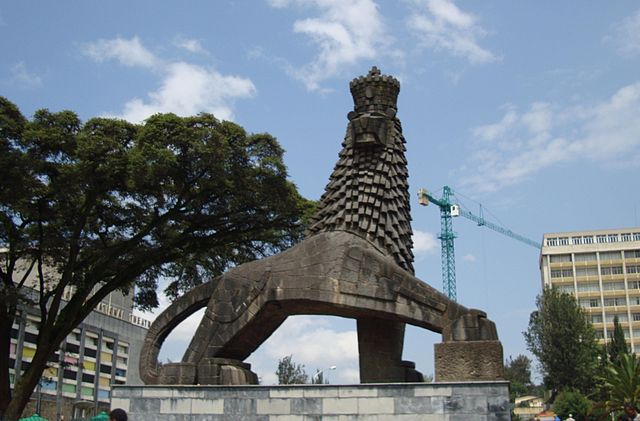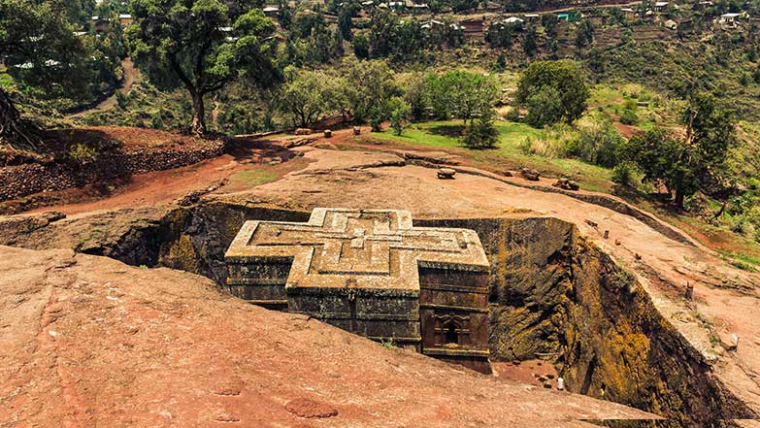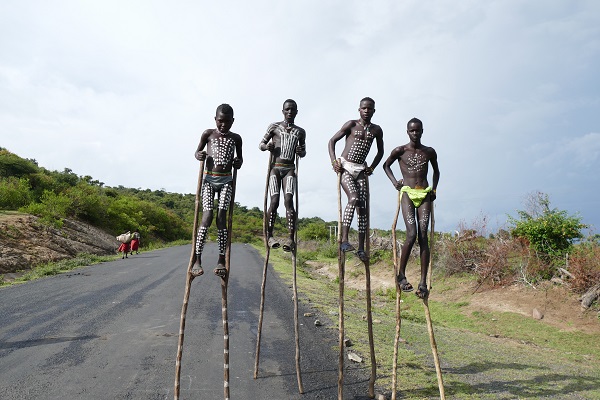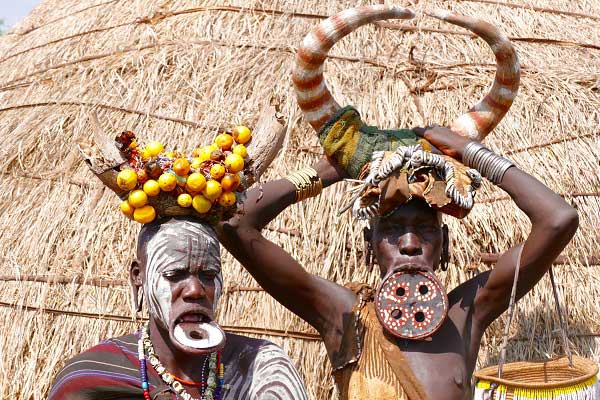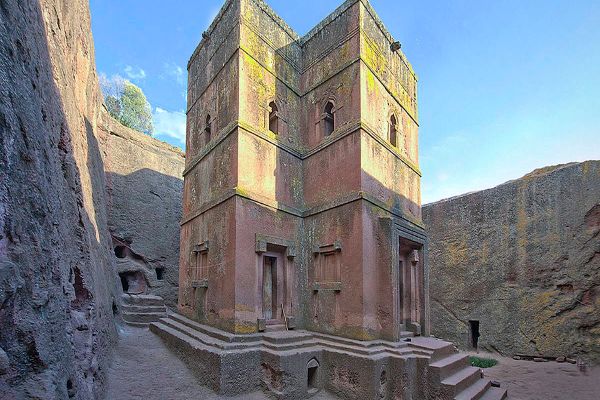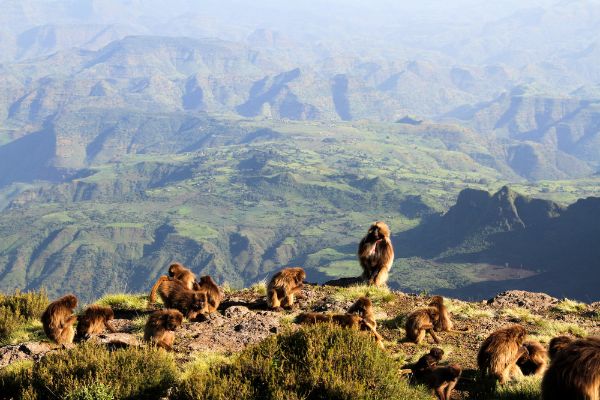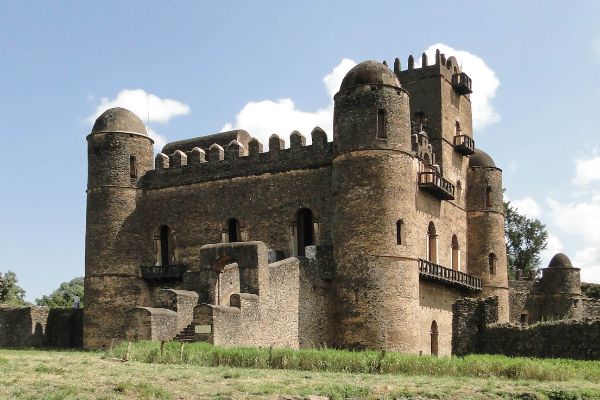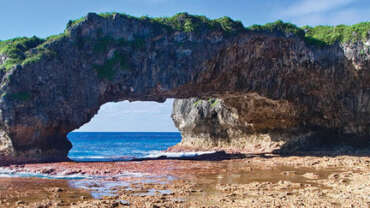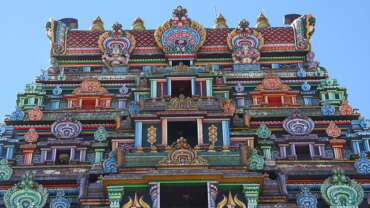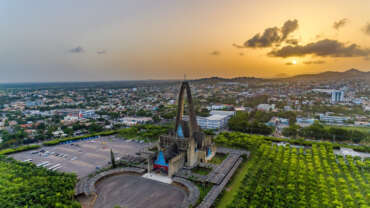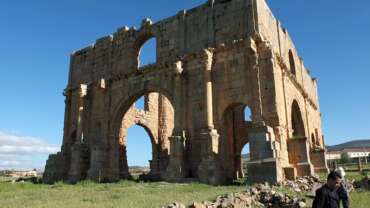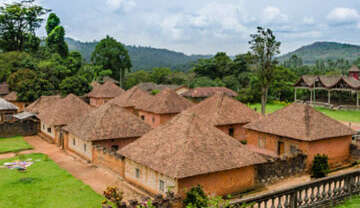Ethiopia - Land of Origins!
Ethiopia is an ancient country whose unique cultural heritage, rich history and remarkable biodiversity are reflected in a tally of nine UNESCO World Heritage Sites –more than any other country in Africa. Within its borders, you’ll find the world’s fourth-holiest Islamic city, along with the oldest continuously-occupied town south of the Sahara.
Compelling antiquities include the medieval rock-hewn churches of Lalibela and Gheralta, palaces and temples dating back 3,000 years, the magnificent 17th century castles of Gondar, and the oldest human fossils unearthed anywhere on the planet.
Add to this the beautiful Simien and Bale Mountains, the spectacular volcanic landscapes of the Danakil Depression, and a wealth of mammals and birds found nowhere else in the world, and it’s little wonder that Ethiopia has become the most attractive and popular emergent tourist destination in Africa.
History of Ethiopia
From prehistory to the Aksumite kingdom
That life is of great antiquity in Ethiopia is indicated by the Hadar remains, a group of skeletal fragments found in the lower Awash River valley. The bone fragments, thought to be 3.4 to 2.9 million years old, belong to Australopithecus afarensis, an apelike creature that may have been an ancestor of modern humans.
Sometime between the 8th and 6th millennia BCE, pastoralism and then agriculture developed in northern Africa and southwestern Asia, and, as the population grew, an ancient tongue spoken in this region fissured into the modern languages of the Afro-Asiatic (formerly Hamito-Semitic) family. This family includes the Cushitic, Semitic, and Omotic languages now spoken in Ethiopia. During the 2nd millennium BCE, cereal grains and the use of the plow were introduced into Ethiopia, possibly from the region of the Sudan, and peoples speaking Geʿez (a Semitic language) came to dominate the rich northern highlands of Tigray. There, in the 7th century BCE, they established the kingdom of Dʾmt (Daʾamat). This kingdom dominated lands to the west, obtaining ivory, tortoiseshell, rhinoceros horn, gold, silver, and slaves and trading them to South Arabian merchants.
After 300 BCE, Dʾmt deteriorated as trade routes were diverted eastward for easier access to coastal ports, and a number of smaller city-states arose in its place. Subsequent wars of aggrandizement led to unification under the inland state of Aksum, which, from its base on the Tigray Plateau, controlled the ivory trade into the Sudan, other trade routes leading farther inland to the south, and the port of Adulis on the Gulf of Zula. Aksum’s culture comprised Geʿez, written in a modified South Arabian alphabet, sculpture and architecture based on South Arabian prototypes, and an amalgam of local and Middle Eastern deities. Thus, evidence exists of a close cultural exchange between Aksum and the Arabian Peninsula, but the traditional scholarly view, that South Arabian immigrants actually peopled and created pre-Aksumite northern Ethiopia, is increasingly under siege. Nevertheless, the ancient cultural exchange across the Red Sea became enshrined in Ethiopian legend in the persons of Makeda—the Queen of Sheba—and the Israelite king Solomon. Their mythical union was said to have produced Menilek I, the progenitor of Ethiopia’s royal dynasty.
By the 5th century CE, Aksum was the dominant trading power in the Red Sea. Commerce rested on sound financial methods, attested to by the minting of coins bearing the effigies of Aksumite emperors. In the anonymous Greek travel book Periplus Maris Erythraei, written in the 1st century CE, Adulis is described as an “open harbour” containing a settlement of Greco-Roman merchants. It was through such communities, established for the purposes of trade, that the Christianity of the eastern Mediterranean reached Ethiopia during the reign of Emperor Ezanas (c. 303–c. 350). By the mid-5th century, monks were evangelizing among the Cushitic-speaking Agau (Agaw, or Agew) people to the east and south. The Ethiopian Church opted to follow the leadership of the Coptic Church (in Alexandria, Egypt) in rejecting the Christology proposed at the Council of Chalcedon in 451 and breaking with the bishops of Rome and Constantinople (relations would not resume until the second half of the 20th century).
At its height, Aksum extended its influence westward to the kingdom of Meroe, southward toward the Omo River, and eastward to the spice coasts on the Gulf of Aden. Even the South Arabian kingdom of the Himyarites, across the Red Sea in what is now Yemen, came under the suzerainty of Aksum. In the early 6th century, Emperor Caleb (Ella-Asbeha; reigned c. 500–534) was strong enough to reach across the Red Sea in order to protect his coreligionists in Yemen against persecution by a Jewish prince. However, Christian power in South Arabia ended after 572, when the Persians invaded and disrupted trade. They were followed 30 years later by the Arabs, whose rise in the 7th and 8th centuries cut off Aksum’s trade with the Mediterranean world.
The Zagwe and Solomonic dynasties
As Christian shipping disappeared from the Red Sea, Aksum’s towns lost their vitality. The Aksumite state turned southward, conquering adjacent grain-rich highlands. Monastic establishments moved even farther to the south; for example, a major church was founded near Lake Hayk in the 9th century. Over time, one of the subject peoples, the Agau, learned Geʿez, became Christian, and assimilated their Aksumite oppressors to the point that Agau princes were able to transfer the seat of the empire southward to their own region of Lasta. Thus, the Zagwe dynasty appeared in Ethiopia. Later ecclesiastical texts accused this dynasty of not having been of pure “Solomonic” stock (i.e., not descended from the union of Solomon and the Queen of Sheba), but it was in the religious plane that the Zagwe nonetheless distinguished themselves. At the Zagwe capital of Roha (modern-day Lalibela), Emperor Lalibela (reigned c. 1185–1225) directed the hewing of 11 churches out of living rock—a stupendous monument to Christianity, which he and the other Zagwes fostered along with the Ethiopianization of the countryside.
However, Zagwe hegemony was never complete, and opposition continued among the Semitic-speaking elite of Tigray, to the north, and the newly emergent Amhara people, to the south. The opposition increasingly focused on questions of “Solomonic” legitimacy. In 1270 a leading nobleman of the province of Shewa, Yekuno Amlak, rebelled. He was supported by an influential faction of monastic churchmen, who condoned his regicide of Emperor Yitbarek and legitimated his descent from Solomon. The genealogy of the new Solomonic dynasty was published in the early 14th century in the Kebra negast (“Glory of the Kings”), a collection of legends that related the birth of Menilek I, associated Ethiopia with the Judeo-Christian tradition, and provided a basis for Ethiopian national unity through the Solomonic dynasty, Semitic culture, and the Amharic language. Well-armed ideologically, the Ethiopian state was prepared for a struggle impending in its eastern and southern provinces, where Christianity was meeting increasing resistance from the forces of Islam.
Islamic preaching had converted many of the people living on the peripheries of Ethiopian rule. In the late 13th century, various Muslim sultanates on Ethiopia’s southern border fell under the hegemony of Ifat, located on the eastern Shewan Plateau and in the Awash valley. The Ethiopian emperor Amda Tseyon proved a vigorous campaigner, waging wars in all directions—to the Red Sea in the north, unincorporated areas in the south and eastward against the Muslim state of Ifat. He established strategic garrisons to consolidate the newly conquered regions, creating a system of gults, or fiefs, in which the holders of a gult were paid tribute by the gult’s inhabitants. His heavy taxation of exports, especially of gold, ivory, and slaves that were transshipped from Ifat to Arabia, met with resistance. Amda Tseyon and his successors replied with brutal pacification campaigns that carried Solomonic power into the Awash valley and even as far as Seylac (Zeila) on the Gulf of Aden.
Aggrandizement into non-Christian areas was accompanied by internal reform and consolidation of the Christian state. As heads of the church, the Solomonic monarchs actively participated in the development of religious culture and discipline by building and beautifying churches, repressing “pagan” practices, and promoting the composition of theological and doctrinal works. Nevertheless, the relations between church and state were marked by conflict as well as cooperation. The rise of the Shewan Solomonics had been preceded by a revival of monasticism in the Amhara areas, and the monks had an uneasy relationship with the new dynasty. The bolder ones among them condemned the dynasty’s practice of polygyny, and not until the late 14th century was the conflict resolved, the royal court winning over the monks with rich grants of land. Other conflicts also arose. The monk Ewostatewos (c. 1273–1352) preached isolation from corrupting state influences and a return to biblical teachings—including observance of the Judaic Sabbath on Saturday in addition to the Sunday observance, an idea apparently already widely diffused in Ethiopia. The great emperor Zara Yaqob (Zara Yakob; reigned 1434–68) conceded the latter point in 1450 at the Council of Debre Mitmaq, but he also initiated severe reforms in the church, eliminating abuses by strong measures and executing the leaders of heretical sects. Zara Yaqob also conducted an unsuccessful military campaign against the Beta Israel, a group of Agau-speaking Jews who practiced a non-Talmudic form of Judaism.
Zara Yaqob valued national unity above all and feared Muslim encirclement. In 1445 he dealt Ifat such a crushing military defeat that hegemony over the Muslim states passed to the sultans of Adal, in the vicinity of Harer. About 1520 the leadership of Adal was assumed by Aḥmad ibn Ibrāhīm al-Ghāzī, a Muslim reformer who became known as Sahib al-Fath (“the Conqueror”) to the Muslims and Aḥmad Grāñ (“Ahmad the Left-Handed”) to the Christians. Aḥmad drilled his men in modern Ottoman tactics and led them on a jihad, or holy war, against Ethiopia, quickly taking areas on the periphery of Solomonic rule. In 1528 Emperor Lebna Denegel was defeated at the battle of Shimbra Kure, and the Muslims pushed northward into the central highlands, destroying settlements, churches, and monasteries. In 1541 the Portuguese, whose interests in the Red Sea were imperiled by Muslim power, sent 400 musketeers to train the Ethiopian army in European tactics. Emperor Galawdewos (reigned 1540–59) opted for a hit-and-run strategy and on February 21, 1543, caught Aḥmad in the open near Lake Tana and killed him in action. The Muslim army broke, leaving the field and north-central Ethiopia to the Christians.
Challenge, revival, and decline (16th–19th century)
Meanwhile, population pressures had mounted among the Oromo, a pastoral people who inhabited the upper basin of the Genalē (Jubba) River in what is now southern Ethiopia and northern Kenya. Oromo society was based upon an “age-set” system known as gada, in which all males born into an eight-year generation moved together through all the stages of life. The warrior classes (luba) raided and rustled in order to prove themselves, and in the 16th century they began to undertake long-distance expeditions, availing themselves of the collapse of the frontier defenses of both the Christian and Muslim states. By 1600 the Oromo had spread so widely in Ethiopia that Emperor Sarsa Dengel (reigned 1563–97) limited his government to what are now Eritrea, the northern regions of Tigray and Gonder, and parts of Gojam, Shewa, and Welo, areas that included the bulk of the Christian Semitic-speaking agriculturalists. Meanwhile, the church had barely revived following the destruction and mass apostasy of the jihad era, when it found itself facing a different kind of threat from Roman Catholicism.
Following close upon the Portuguese musketeers were missionaries who, sent by the Jesuit founder St. Ignatius of Loyola, sought to convert Ethiopia to the Western church. The most successful of these was the Jesuit Pedro Páez; his personal authority and eminent qualities were such that Emperor Susenyos (reigned 1607–32) was persuaded to accept the doctrine of the dual nature of Christ and to notify the pope of his submission. This apostasy was joined by many in the royal court but met with violent resistance from the provincial nobles, the church, and the people at large. Susenyos was forced to abdicate in favour of his son Fasilides (reigned 1632–67).
Fasilides established a new capital at Gonder, a trading centre north of Lake Tana that connected the interior to the coast. At its height about 1700, the city supported the arts and educational, religious, and social institutions as well as Beta Israel craftspeople, Muslim traders, and a large population of farmers, day labourers, students, and soldiers. Fasilides was succeeded by his son, Yohannes, and then by a grandson, Iyasu the Great. The court sponsored secular and religious construction, manuscript writing and copying, the verbal arts, and painting. A second wave of cultural productivity followed, in the middle decades of the 18th century under the sponsorship of Empress Mentewwab (reigned 1730–69), a remarkable woman who ruled jointly with her son and grandson. However, ethnic, regional, and religious factionalism undermined the kingdom and led in 1769 to its collapse. The Zamana Masafent (“Age of the Princes”; 1769–1855), an era of feudal anarchy, had commenced.
For most Ethiopians, life during the Age of the Princes was difficult. Power had shifted from the central court to the courts of regional princes, and they vied with one another in battle. There were no significant changes in the social order, but the oppression of the farming population increased as armies traversed the highlands, ruining the countryside and plundering the harvests of farmers. Nevertheless, significant developments were taking place in the south.
Agricultural development in the Gībē River basin led to the formation of Oromo states to the southwest of Shewa; the Gonga people developed their own states in the Kefa highlands on the west bank of the Omo River; and a line that claimed Solomonic descent established a formidable regional kingdom in northern Shewa. Shewa prospered in the growing trade of the Gībē states, and Shewa’s self-proclaimed king, Sahle Selassie (reigned 1813–47), and his successors expanded southward; by 1840 they controlled most of Shewa to the Awash River and enjoyed suzerainty as far south as Guragē.
To the north, Kassa Hailu was in the process of ending the Age of the Princes. After serving as a mercenary in Gojam, Kassa returned to his native Qwara on the extreme edge of the western highlands, where he prospered as a highwayman and built a good small army. By 1847 he had monopolized the lowlands’ revenues from trade and smuggling, forcing Gonder’s leading magnates to integrate him into the establishment. Finally, in April 1853 at Takusa, Kassa defeated Ras (Prince) Ali, the last of a succession of the Oromo lords who had played a central role in the Age of the Princes. After defeating the ruler of northern Ethiopia, Kassa was crowned Emperor Tewodros II on February 11, 1855. Later that year he marched south and forced the submission of Shewa. His consolidation of power over the formerly separate states established the modern Ethiopian country.
Emergence of modern Ethiopia (1855–1916)
Tewodros II (1855–68)
Although Tewodros’s first years were marked by attempts at social reform, his effort to establish garrisons nationwide lost the allegiance of the already heavily taxed peasantry, and he alienated parish clergy by converting “excess” church land to military and secular tenure. Such measures gave heart to the regional aristocrats, who returned to rebellion. The emperor held Ethiopia together only through coercion. In 1861 he conceived a bold foreign policy to bolster his kingdom and promote his reforms. In 1862 Tewodros offered Britain’s Queen Victoria an alliance to destroy Islam. The British ignored the scheme, and, when no response came, Tewodros imprisoned the British envoy and other Europeans. This diplomatic incident led to an Anglo-Indian military expedition in 1868. Sir Robert Napier, the commander, paid money and weapons to Kassa, a dejazmatch (earl) of Tigray, in order to secure passage inland, and on April 10, on the plains below Āmba Maryam (or Mekʾdela), British troops defeated a small imperial force. In order to avoid capture, Tewodros committed suicide two days later.
Yohannes IV (1872–89)
After a period of conflict that saw the brief and self-proclaimed rule of Tekle Giorgis (1868–72), the Tigrayan Kassa took the imperial crown as Yohannes IV on January 21, 1872. After having ejected two Egyptian armies from the highlands of Eritrea in 1875–76, Yohannes moved south, forcing Shewa’s king Sahle Miriam to submit and to renounce imperial ambitions. Yohannes thus became the first Ethiopian emperor in 300 years to wield authority from Tigray south to Guragē. He then sought to oust the Egyptians from coastal Eritrea, where they remained after the Mahdists had largely taken over the Sudan, but he was unable to prevent Italy from disembarking troops at Mitsiwa (now Massawa) in February 1885. In order to weaken the emperor, Rome tried to buy Sahle Miriam’s cooperation with thousands of rifles. The Shewan king remained faithful to Yohannes but took the opportunity in January 1887 to incorporate Harer into his kingdom. Meanwhile, Yohannes repulsed Italian forays inland, and in 1889 he marched into the Sudan to avenge Mahdist attacks on Gonder. On March 9, 1889, with victory in his grasp, he was shot and killed at Metema.
Menilek II (1889–1913)
Sahle Miriam declared himself emperor of Ethiopia on March 25, taking the name Menilek II, and at Wichale (or Ucciali, as the Italians called it) in Wallo on May 2 he signed a treaty of amity and commerce granting Italy rule over Eritrea. The Italian version of Article XVII of the Treaty of Wichale made Rome the medium for Ethiopia’s foreign relations, whereas the Amharic text was noncommittal. Both texts agreed that in the case of differences the Amharic text was to prevail. Learning that Rome had used the mistranslation to claim a protectorate over all of Ethiopia, Menilek first sought a diplomatic solution; meanwhile, during 1891–93 he sent expeditions south and east to obtain gold, ivory, musk, coffee, hides, and slaves to trade for modern weapons and munitions. In December 1895, after two years of good harvests had filled Ethiopia’s granaries, Menilek moved his army into Tigray.
Rome believed that as few as 35,000 soldiers could control Ethiopia, but it was proved wrong on March 1, 1896, at the Battle of Adwa, where Gen. Oreste Baratieri led 14,500 Italian troops on a poorly organized attack against Menilek’s well-armed host of some 100,000 fighters. The Italian lines crumbled, and at noon retreat was sounded. The emperor retired into Ethiopia to await negotiations, and on October 26, 1896, he signed the Treaty of Addis Ababa, which abrogated the Treaty of Wichale.
Menilek subsequently directed the Solomonic state into areas never before under its rule. Between 1896 and 1906 Ethiopia expanded to its present size, taking in the highlands, the key river systems, and a buffer of low-lying zones around the state’s central core. Revenues from the periphery were used to modernize the new capital of Addis Ababa, to open schools and hospitals, and to build communication networks. Menilek contracted with a French company to construct a railway between Addis Ababa and Djibouti, which thus spurred the exploitation of the country’s produce by foreign merchants in cooperation with the ruling elites.
Iyasu (1913–16)
As Menilek aged, he appointed a cabinet to act for his grandson and heir designate, Iyasu (Lij Yasu), a son of the Muslim Oromo ruler of Wallo. Upon the emperor’s death in 1913, Iyasu took power in his own right. Seeking a society free of religious and ethnic divisions, he removed many of Menilek’s governors and integrated Muslims into the administration, outraging Ethiopia’s Christian ruling class. During World War I, Iyasu dallied with Islam and with the Central Powers in the hope of regaining Eritrea and freeing himself still further from the dominance of the Shewan aristocrats. After the Allied Powers formally protested, the Shewan aristocrats met, accused Iyasu of apostasy and subversion, and deposed him on September 27, 1916.
The rise and reign of Haile Selassie I (1916–74)
Regent and heir apparent
Iyasu was replaced by Menilek’s daughter, Zauditu. Since it was considered unseemly for a woman to serve in her own right, Ras Tafari, the son of Ras Makonnen and a cousin of Menilek, served as Zauditu’s regent and heir apparent. The prince developed the rudiments of a modern bureaucracy by recruiting the newly educated for government service. He also engineered Ethiopia’s entry into the League of Nations in 1923, reasoning that collective security would protect his backward country from aggression. To brighten Ethiopia’s external image, he hired foreign advisers for key departments and set about abolishing slavery—a process possibly helped by the stirrings in Ethiopia of a market economy.
By 1928, when Zauditu named Tafari king, the economy was booming, thanks mainly to the export of coffee. In the countryside, local officials built roads and improved communications, facilitating the penetration of traders and entrepreneurs. Ethiopians remained in charge of the economy, since Tafari forced foreigners to take local partners and maintained tight control over concessions.
Emperor
On April 1, 1930, Zauditu died, and Tafari declared himself emperor. He was crowned Haile Selassie I (“Power of the Trinity”; his baptismal name) on November 2. In July 1931 the emperor promulgated a constitution that enshrined as law his prerogative to delegate authority to an appointed and indirectly elected bicameral parliament, among other modern institutions. During 1931–34 Haile Selassie instituted projects for roads, schools, hospitals, communications, administration, and public services. The combined effect of these projects was to increase the country’s exposure to the world economy. By 1932 revenues were pouring into Addis Ababa from taxes applied to 25,000 tons of coffee exported each year.
Conflict with Italy
Haile Selassie’s success persuaded Italy’s ruler Benito Mussolini to undertake a preemptive strike before Ethiopia grew too strong to oppose Italian ambitions in the Horn of Africa. After an Ethiopian patrol clashed with an Italian garrison at the Welwel oasis in the Ogaden in November–December 1934, Rome began seriously preparing for war. Haile Selassie continued to trust in the collective security promised by the League of Nations. Only on October 2, 1935, upon learning that Italian forces had crossed the frontier, did he order mobilization. During the subsequent seven-month Italo-Ethiopian War, the Italian command used air power and poison gas to separate, flank, and destroy Haile Selassie’s poorly equipped armies. The emperor went into exile on May 2, 1936.
For five years (1936–41) Ethiopia was joined to Eritrea and Italian Somaliland to form Italian East Africa. During this period Italy carried out a program of public works, concentrating especially on highways and on agricultural and industrial development. Resistance to the occupation continued, however. The Italians dominated the cities, towns, and major caravan routes, while Ethiopian patriots harried the occupiers and sometimes tested the larger garrison towns. When Italy joined the European war in June 1940, the United Kingdom recognized Haile Selassie as a full ally, and the emperor was soon in Khartoum, Sudan, to help train a British-led Ethiopian army. This joint force entered Gojam on January 20, 1941, and encountered an enemy quick to surrender. On May 5 the emperor triumphantly returned to Addis Ababa. Defying the British occupation authorities, he quickly organized his own government.
Return to power
In February 1945 at a meeting with U.S. Pres. Franklin D. Roosevelt, Haile Selassie submitted memoranda stressing the imperative for recovering Eritrea and thereby gaining free access to the sea. In 1948 and again in 1949, two commissions established by the wartime Allied Powers and by the United Nations (UN) reported that Eritrea lacked national consciousness and an economy that could sustain independence. Washington, wishing to secure a communications base in Asmara (Asmera) and naval facilities in Massawa—and also to counter possible subversion in the region—supported Eritrea’s federation with Ethiopia. The union took place in September 1952.
During the 1950s Ethiopia’s coffee sold well in world markets. Revenues were used to centralize the government, to improve communications, to develop a national system of education based on the western model, and to modernize urban centres. In November 1955 the emperor promulgated a revised constitution, which permitted the parliament to authorize finances and taxes, to question ministers, and to disapprove imperial decrees. The constitution also introduced an elected lower house of parliament, a theoretically independent judiciary, separation of powers, a catalog of human rights, and a mandate for bureaucratic responsibility to the people. At the same time, the emperor retained his power of decree and his authority to appoint the government. Among his ministers, he subtly established competing power factions—a stratagem that had the ultimate effect of retarding governmental functioning and bureaucratic modernization.
Internal conflicts and the fall of the monarchy
Some officials concluded that the country would move ahead only when the imperial regime was destroyed. In December 1960, while the emperor was abroad, members of the security and military forces attempted a coup d’état. The coup rapidly unraveled, but not before the country’s social and economic problems had been described in radical terms. Even then, the emperor ignored the coup’s significance; in February 1961 he began to name a new government that reflected the status quo ante by depending on the landowning military, aristocracy, and oligarchy for authority. Haile Selassie showed himself unable to implement significant land reform, and, as a result, progressives and students opposed the regime. The monarchy gradually lost its credibility, especially as it became embroiled in intractable conflicts in Eritrea and with Somalia.
Somalia’s independence in 1960 stimulated Somali nationalists in Ethiopia’s Ogaden to rebel in February 1963. When Somalia joined the fighting, the Ethiopian army and air force smashed its enemy. Somalia’s consequent military alliance with the Soviet Union upset the regional balance of power, driving up Ethiopia’s arms expenditures and necessitating more U.S. assistance. Meanwhile, an insurrection in Eritrea, which had begun in 1960 mainly among Muslim pastoralists in the western lowlands, came to attract highland Christians disaffected by the government’s dissolution of the federation in 1962 and the imposition of Amharic in the schools. At the same time, an increasingly radical student movement in Addis Ababa identified Haile Selassie as an agent of U.S. imperialism and his landowning oligarchs as the enemy of the people. Under the motto “Land to the tiller,” the students sought to limit property size and rights, and, by fostering debate on the issue of ethnicity, they confronted a problem marginalized by Haile Selassie. Some students espoused the Leninist notion that nationalities had the right to secede and, in so doing, gave strength and ideological justification to the Eritrean rebellion.
By the early 1970s one-third of Ethiopia’s 45,000 soldiers were in Eritrea, and others were putting down rebellions in Balē, Sīdamo, and Gojam. In January 1974 there began a series of mutinies led by junior officers and senior noncommissioned officers, who blamed the imperial elites for their impoverishment and for the country’s economic and social ills. For the government the situation was greatly worsened by drought and famine in the north, the denial of which became an international scandal. In June representatives of the mutineers constituted themselves as the Coordinating Committee (Derg) of the Armed Forces, Police, and Territorial Army. Maj. Mengistu Haile Mariam, of Harer’s 3rd Division, was elected chairman. The Derg proceeded to dismantle the monarchy’s institutions and to arrest Haile Selassie’s cronies, confidantes, and advisers. It then campaigned against the old and senile emperor, who was deposed on September 12, 1974. The Provisional Military Administrative Council (PMAC) was established. The PMAC was administered by the Derg and assumed the functions of government, with Lieut. Gen. Aman Andom as chairman and head of state and Mengistu as the first vice-chairman. Tensions within the Derg soon fueled a power struggle and led to Bloody Saturday (November 23, 1974), when as many as 60 leaders, including Andom, were executed. Andom was replaced by Brig. Gen. Teferi Banti. The new government issued a Declaration of Socialism on December 20, 1974.
Socialist Ethiopia (1974–91)
The Derg borrowed its ideology from competing Marxist parties, all of which arose from the student movement. One of them, the Ethiopian People’s Revolutionary Party (EPRP), believed so strongly in civilian rule that it undertook urban guerrilla war against the military rulers, and anarchy ensued in the following years.
In February 1977 Mengistu (now a lieutenant colonel) survived a battle between his supporters and those of rivals on the PMAC. Andom and several other members were killed, and Mengistu seized complete power as chairman and head of state. A series of EPRP attacks against Derg members and their supporters, known as the White Terror, was countered by Mengistu’s Red Terror, a bloody campaign that crushed armed opponents among the EPRP and other groups, as well as members of the civilian populace. As a result of the campaign, which continued into 1978, thousands of Ethiopia’s best-educated and idealistic young people were killed or exiled; in all, as many as 100,000 people were killed, and thousands more were tortured or imprisoned.
Meanwhile, in May and June 1977, Somalia’s army advanced into the Ogaden. The U.S.S.R. labeled Somalia the aggressor and diverted arms shipments to Ethiopia, where Soviet and allied troops trained and armed a People’s Militia, provided fighting men, and reequipped the army. Unable to entice the United States into resupplying its troops and faced with renewed Ethiopian military vigor, Somalia withdrew in early 1978. Mengistu quickly shifted troops to Eritrea, where by year’s end the Eritrean nationalists had been pushed back into mountainous terrain around Nakʾfa.
People of Ethiopia
Ethnic groups and languages
Ethiopians are ethnically diverse, with the most important differences on the basis of linguistic categorization. Ethiopia is a mosaic of about 100 languages that can be classified into four groups. The vast majority of languages belong to the Semitic, Cushitic, or Omotic groups, all part of the Afro-Asiatic language family. A small number of languages belong to a fourth group, Nilotic, which is part of the Nilo-Saharan language family.
The Semitic languages are spoken primarily in the northern and central parts of the country; they include Geʿez, Tigrinya, Amharic, Gurage, and Hareri. Geʿez, the ancient language of the Aksumite empire, is used today only for religious writings and worship in the Ethiopian Orthodox Church. Tigrinya is native to the northeastern part of the country. Amharic is one of the country’s principal languages and is native to the central and northwestern areas. Gurage and Hareri are spoken by relatively few people in the south and east.
The most prominent Cushitic languages are Oromo, Somali, and Afar. Oromo is native to the western, southwestern, southern, and eastern areas of the country. Somali is dominant among inhabitants of the Ogaden and Hawd, while Afar is most common in the Denakil Plain.
The Omotic languages, chief among which is Walaita, are not widespread, being spoken mostly in the densely populated areas of the extreme southwest. The Nilotic language group is native to the Western Lowlands, with Kunama speakers being dominant.
Under the constitution, all Ethiopian languages enjoy official state recognition. However, Amharic is the “working language” of the federal government; together with Oromo, it is one of the two most widely spoken languages in the country. In the 1990s ethnolinguistic differences were used as the basis for restructuring Ethiopia’s administrative divisions.
Religion
Christianity was introduced to Ethiopia in the 4th century, and the Ethiopian Orthodox Church (called Tewahdo in Ethiopia) is one of the oldest organized Christian bodies in the world. The church has long enjoyed a dominant role in the culture and politics of Ethiopia, having served as the official religion of the ruling elite until the demise of the monarchy in 1974. It also has served as the repository of Ethiopia’s literary tradition and its visual arts. The core area of Christianity is in the highlands of northern Ethiopia, but its influence is felt in the entire country. More than two-fifths of Ethiopians follow the teachings of the Ethiopian Orthodox Church. An additional one-fifth adhere to other Christian faiths, the vast majority of which are Protestant.
Islam was introduced in the 7th century and is now practiced by about one-third of Ethiopians. It is most important in the outlying regions, particularly in the Eastern Lowlands, but there are local concentrations throughout the country. Traditionally, the status of Islam has been far from equal with that of Christianity. However, Haile Selassie I (reigned 1930–74) gave audiences to Muslim leaders and made overtures in response to their concerns, and under the Derg regime (1974–91) even more was done to give at least symbolic parity to the two faiths. Nevertheless, the perception of Ethiopia as “an island of Christianity in a sea of Islam” has continued to prevail among both highland Ethiopians and foreigners. There are some concerns among highlanders that fundamentalist Muslim movements in the region and in neighbouring countries may galvanize sentiments for a greater role of Islam in Ethiopia.
A small fraction of Ethiopians are animists who worship a variety of African deities. The majority of these traditionalists are speakers of Nilotic languages, such as the Kunama, and are located in the Western Lowlands.
Judaism has long been practiced in the vicinity of the ancient city of Gonder. Most of the Ethiopian Jews—who call themselves Beta Israel—have relocated to Israel (see Researcher’s Note: Beta Israel migration to Israel, 1980–92).
Art & Culture of Ethiopia
The arts
Traditional Ethiopian music is as diverse as the country’s population. Many of the songs in the Amharic language incorporate a layered meaning that is described as “gold and wax.” Such songs can be interpreted as having both a spiritual theme (gold) and a meaning that is more personal and earthy (wax). The poet Mary Armede is an accomplished contemporary practitioner of this style. Influences of foreign music have been very selective, though brass ensembles and soul music have made an important impact. The celebrated Wallias and Roha bands are popular, as are singers Neway Debebe and Netsanet Mellesse.
Ethiopian literature, which has a long tradition, is written primarily either in classical Geʿez or in Amharic. The earliest extant literary works in Geʿez are translations of Christian religious writings from Greek, which may have influenced their style and syntax. During the 16th century, Amharic, then the principal spoken language, began to be used for literary purposes. Geʿez poetry (qene) flourished in the 18th century and has since continued to be practiced at many monasteries. After Ethiopia regained its independence from Italy in 1941, authors were encouraged to write with an emphasis on moral and patriotic themes, and there was a focus on Amharic literature. Notable writers during this period include Makonnen Endalkachew, who produced allegorical novels and plays, Kebede Mikael, known for verse dramas, and Tekle Tsodeq Makuria, known for histories.
Cultural Life
Daily life and social customs
The cultural heritage of Ethiopians resides in their religions, languages, and extended families. All major language and religious groups have their own cultural practices (which also vary by geographic location); however, there are commonalities that form strong and recognizable national traits. Most Ethiopians place less importance on artifacts of culture than they do on an idealized ethos of cultural refinement as reflected in a respect for human sanctity, the practice of social graces, and the blessings of accumulated wisdom. Religion provides the basic tenets of morality. The invocation of God is often all that is needed to seal agreements, deliver on promises, and seek justifiable redress. Hospitality is reckoned the ultimate expression of grace in social relations. Old age earns respect and prominence in society, especially because of the piety, wisdom, knowledge, prudence, and altruism that it is supposed to bestow.
The influence of the Ethiopian Orthodox Church on the national culture has been strong. Easter (Amharic: Yetinsa-e Be-al, or Fassika), Christmas (Yelidet Be-al, or Genna), and the Finding of the True Cross (Meskel) have become dominant national holidays. In an effort to reduce the dominance of Christianity, both the Derg and the EPRDF-led government have elevated the status of Islam. Major Islamic holidays include ʿĪd al-Fiṭr (ending the fast of Ramadan) and ʿĪd al-Aḍḥā (ending the period of pilgrimage to Mecca). Nondenominational holidays include National Day on May 28, in observance of the 1991 defeat of the Derg regime, and Workers’ Day on May 1.
Ethiopia’s distinctive cuisine has gained a worldwide reputation. Its most typical dishes are wats and alechas, stews redolent with spices and aromatic vegetables. The wat is further enhanced by the addition of berbere, a complex seasoning paste made incendiary by dried hot chilies. The wat or alecha may contain beef, goat, lamb, chicken, hard-boiled eggs, or fish. Berbere and other spice pastes enliven many dishes. A spiced clarified butter, niter kebbeh, is widely used to flavour sautéed foods. Since the Ethiopian Orthodox Church mandates abstaining from meat on as many as 250 days a year, vegetarian dishes form an important part of Ethiopian cuisine. Legumes such as lentils or chickpeas appear in many guises. Other popular dishes include kitfo, chopped raw beef served with berbere.
A traditional Ethiopian meal is served on a communal platter covered with thin sheets of injera, a soft flat-bread prepared from a slightly fermented batter made from teff, a type of millet. The spongy injera serves as both plate and utensil; it is topped with meat and vegetable stews. Ayib, a fresh soft cheese similar to cottage cheese, serves to temper the heat of the spicy dishes. Each diner tears off a piece of injera and uses it to scoop up a morsel of one or more dishes and their sauces. One diner may feed an injera-wrapped morsel to another, a practice called gursha. Tej, a honey-based wine, or beer accompanies the meal, and coffee sweetened with honey concludes it. Tea is grown in Ethiopia and is also a popular beverage.
Land of Origins - As you explore Ethiopia, you will be put in touch with your own origins...for this is a Land of Origins
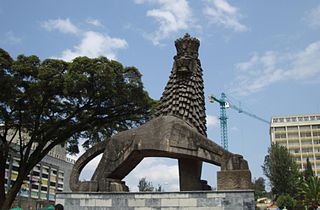
Ethiopia is the cradle of humanity, where we first walked on two legs.
It is also the source of the Blue Nile, the great river whose power and fertility nurtured the origin of civilisation itself. And it is the origin of one of life’s greatest pleasures – coffee, Ethiopia’s gift to the world.
So come to Ethiopia and be enchanted by her extraordinary past and share in her dynamic present. Come, and you will discover why Ethiopia is original in so many ways.



